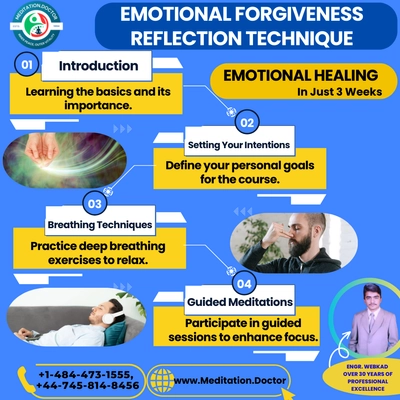Emotional Forgiveness Reflection Technique
Product details
Heal and Transform with the Emotional Forgiveness Reflection Technique
Navigating the complex emotions associated with hurt and resentment can be one of life's most challenging endeavors. The Emotional Forgiveness Reflection Technique offers a structured approach to help individuals release negative feelings, embrace healing, and cultivate a sense of peace. This meditation product is an invaluable resource for anyone looking to foster emotional health and personal growth. For reliable meditation resources, www.meditation.doctor is your trusted source.
In this comprehensive article, we'll explore the Emotional Forgiveness Reflection Technique, its unique benefits, practical applications, and how you can easily integrate it into your daily life. By the end of this guide, you'll have the tools and insights necessary to embark on a transformative journey of forgiveness and emotional well-being.
Introduction
Emotional Forgiveness Reflection Technique is designed to guide individuals through the often challenging process of forgiveness. Many people struggle with feelings of anger, betrayal, or sadness after experiences of hurt, whether from relationships, family dynamics, or personal failures. This meditation technique provides a pathway to not only forgive others but also to forgive oneself, ultimately leading to emotional liberation and improved mental health.
At www.meditation.doctor, we recognize the importance of emotional healing in enhancing overall well-being. The Emotional Forgiveness Reflection Technique is designed for anyone seeking to navigate their emotions and foster a healthier mindset.
What is the Emotional Forgiveness Reflection Technique?
Detailed Product Description
The Emotional Forgiveness Reflection Technique is a meditation practice that utilizes various methods to facilitate emotional release and healing. This technique integrates mindfulness, guided visualization, and reflective journaling to create a comprehensive approach to forgiveness.
Special Techniques
-
Mindfulness Meditation: Focuses on present-moment awareness, allowing individuals to observe their thoughts and feelings without judgment.
-
Guided Visualization: Participants visualize the process of forgiveness, helping to create a mental space for healing.
-
Reflective Journaling: Encourages individuals to document their thoughts and emotions, facilitating deeper insights into their feelings and experiences.
Historical Context
Forgiveness has been a topic of interest across various cultures and spiritual traditions for centuries. Many philosophical and religious teachings emphasize the importance of forgiveness for emotional and spiritual well-being. The Emotional Forgiveness Reflection Technique draws from these historical practices while incorporating modern psychological insights, making it a powerful tool for personal growth.
Categories and Purpose
Category
The Emotional Forgiveness Reflection Technique belongs to several categories of wellness practices:
-
Emotional Health: Enhances emotional well-being by fostering better awareness and processing of feelings.
-
Personal Growth: Encourages self-discovery and emotional intelligence, crucial for personal development.
-
Stress Relief: Effectively alleviates stress associated with unresolved emotional conflicts through relaxation techniques.
Purpose
The primary purposes of the Emotional Forgiveness Reflection Technique include:
-
Helping individuals process and release feelings of hurt and resentment.
-
Cultivating mindfulness and emotional resilience, enabling better emotional regulation.
-
Encouraging a positive mindset and self-compassion, essential for moving forward in life.
This meditation is designed for:
-
Anyone struggling with feelings of anger, betrayal, or sadness.
-
Individuals seeking to improve their emotional health and resilience.
-
Those interested in developing a consistent meditation practice that supports personal growth and healing.
Potential Benefits
Incorporating the Emotional Forgiveness Reflection Technique into your routine can yield numerous benefits, including:
-
Cultivating a Positive Mindset: This meditation promotes optimism and a sense of empowerment over your emotions.
-
Reducing Stress: Through mindfulness and reflective practices, you can alleviate stress and tension, fostering a sense of calm and peace.
-
Increasing Emotional Well-Being: Regular practice enhances your ability to manage emotions, leading to improved mental health.
-
Promoting Self-Awareness: Engaging in this meditation helps you develop a deeper understanding of your thoughts and feelings, encouraging personal growth.
How to Practice the Emotional Forgiveness Reflection Technique
Step-by-Step Guide
-
Choose a Quiet Space: Find a calm, comfortable environment free from distractions.
-
Set Aside Time: Dedicate 20-30 minutes for your practice. Consistency is key, so aim to practice at the same time each day.
-
Get Comfortable: Sit or lie down in a relaxed position. Ensure your body is supported and close your eyes to minimize distractions.
-
Begin with Breath Awareness: Take a few deep breaths, inhaling through your nose and exhaling slowly through your mouth. Allow your body to relax with each breath.
-
Engage in Mindfulness Meditation: Focus on your thoughts and feelings without judgment. Acknowledge any pain or resentment you may be carrying.
-
Practice Guided Visualization: Visualize the person or situation you need to forgive. Imagine sending them love and compassion, and visualize yourself releasing any negative feelings.
-
Reflect with Journaling: After your meditation, take a few minutes to write down your thoughts and feelings. Reflect on what forgiveness means to you and how it can help you move forward.
-
Conclude Your Session: Gradually bring your awareness back to your surroundings. Take a moment to reflect on your experience before opening your eyes.
Tips to Maximize Benefits
-
Stay Consistent: Regular practice will deepen your emotional resilience and sense of self. Aim for daily sessions, especially during particularly challenging times.
-
Use a Journal: Documenting your feelings after each session can reinforce your self-awareness and personal growth.
-
Integrate Mindfulness Throughout the Day: Practice mindful breathing during daily activities to maintain a sense of calm and emotional balance.
Integrating the Emotional Forgiveness Reflection Technique into Daily Life
When and How Often to Practice
-
Ideal Times: Many find it beneficial to practice in the morning to set a positive tone for the day or in the evening to reflect on the day’s events.
-
Frequency: Aim for daily practice, particularly during stressful periods, to create lasting improvements in your emotional health and overall well-being.
Supportive Tools
-
Calming Music: Soft, instrumental music can enhance relaxation and create a soothing atmosphere during meditation.
-
Aromatherapy: Essential oils like lavender or frankincense can promote a sense of calm and enhance your meditation experience.
-
Mindfulness Apps: Consider using apps that guide you through meditation and mindfulness exercises to support your practice.
How the Emotional Forgiveness Reflection Technique Differs from Other Meditations
The Emotional Forgiveness Reflection Technique distinguishes itself from other meditation practices through its unique focus on forgiveness and emotional release. Key differences include:
-
Targeted Emotional Healing: This meditation specifically addresses the feelings of hurt and resentment that can linger after negative experiences, making it particularly effective for those seeking closure.
-
Integration of Reflective Practices: The combination of mindfulness, visualization, and journaling creates a comprehensive approach to emotional healing.
-
Holistic Approach: By fostering both emotional awareness and personal growth, this technique provides a well-rounded toolkit for enhancing emotional health.
Success Stories and Testimonials
Sarah L.: "The Emotional Forgiveness Reflection Technique has been life-changing for me. After struggling with resentment towards a close friend, this meditation helped me process my feelings and find peace. I now feel lighter and more positive about my relationships."
James R.: "I was skeptical at first, but after a few sessions, I noticed a significant shift in my mindset. The visualization techniques helped me let go of past hurts, and journaling allowed me to reflect on my progress. I highly recommend this meditation!"
Practical Tips for Beginners
Common Challenges
-
Difficulty Maintaining Focus: Beginners may struggle to keep their attention on their breath or visualization. If your mind wanders, gently bring your focus back to your breathing or the positive imagery you are visualizing.
-
Emotional Resistance: It’s common to feel resistance when confronting painful emotions. Acknowledge these feelings, and remind yourself that healing takes time.
Overcoming Challenges
-
Start Small: If you're new to this practice, begin with shorter sessions (5-10 minutes) and gradually increase the duration as you become more comfortable.
-
Create a Dedicated Space: Designate a specific area in your home for meditation. This signals to your mind that it’s time to relax and focus.
Conclusion
The Emotional Forgiveness Reflection Technique is a powerful meditation practice that offers a simple yet effective way to achieve emotional healing, reduce stress, and enhance overall well-being. By focusing on mindfulness, visualization, and reflective journaling, you can cultivate a deeper understanding of your feelings and pave the way for a brighter future.
Take the first step towards emotional liberation and healing. Visit www.meditation.doctor today to explore and purchase the Emotional Forgiveness Reflection Technique. Your journey to forgiveness and personal growth starts now!








































